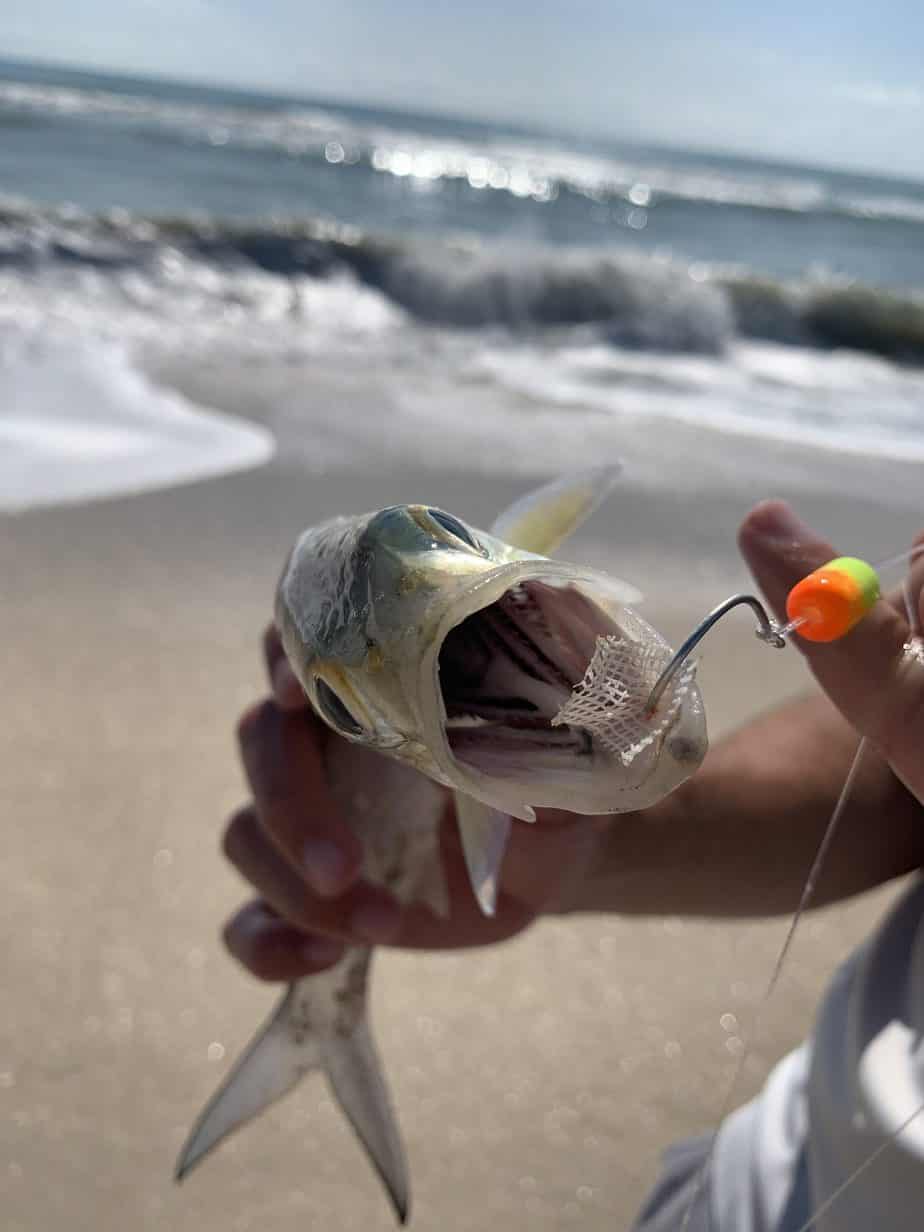A common question I am commonly asked about surf fishing is, what kind of fish can be caught from the beach? The answer to this is, there are hundreds of different types of fish that be caught from the beach while surf fishing. Depending on the season and location will determine what fish will be most active. The most common fish caught from the beach year-round is the saltwater catfish and whiting. The most popular fish to target from the beach beach beach fishing anglers is the pompano, redfish, black drum, and shark.
In this article, we will be going over the top 10 most common fish that can be caught from the beach. In each section, we will also briefly go over some key aspects of the fish to include how to identify them, when and where to catch them, their feeding preferences and patterns, as well as best baits and rigs to catch them.
1. Catfish
For most angler, the catfish is more of a nuisance than anything else. However, the catfish has to make it on the list because you will probably catch 2 times more catfish than anything else in the water. Anglers still like to catch them for their constant action and decent pull, but they're are general returned to the water and rarely harvested. Catfish can be caught in almost any salt water location, including beaches, in the US.
Catfish are pretty easy to identify. They have a wide and semi flat head with large whiskars on either side of their mouth. They are brown or grey on top that fades into a white belly and have a prominent spine on the dorsal and pectoral fins that actually contain a poisonous venom that causes pain like a bee sting if stung. Saltwater catfish are generally anywhere from 1 to 5 pounds when caught from the beach but can get much larger in size.
Catfish are bottom dwelling fish that will eat nearly anything that doesn't eat them first. They are especially attracted to dead cutbait that is oily and pungent in smell. I have found that catfish are most commonly caught with small chunks of dead shrimp as well as cut baitfish such as mullet and ladyfish. I have also caught many catfish when rigged up with fishbites in any flavor available.
2. Whiting
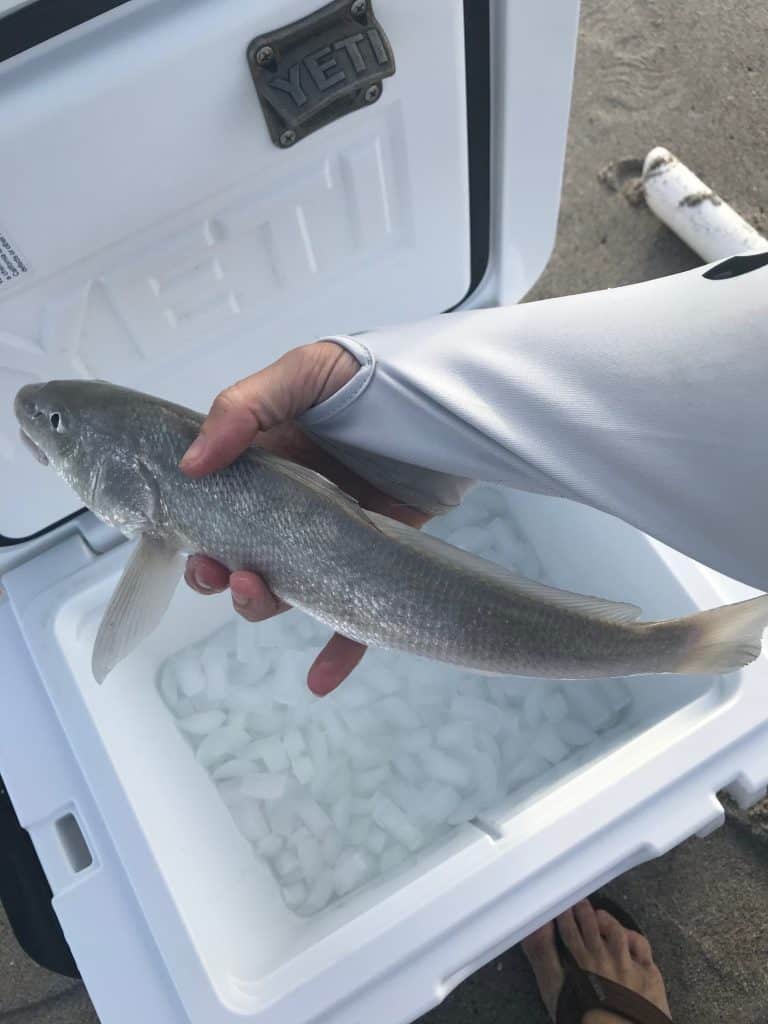
Next to the catfish, whiting is one of the most popular and abundant fish that is caught while fishing from the beach. These fish are popular because they are very easy to catch, are generally unregulated, meaning there are typically no size or quantify regulations for harvest, and taste great. Whiting can be caught year around along any beach on the Gulf and Atlantic coasts.
Whiting is the general name that refers to three species of “kingfish”, the Souther Kingfish, Northern Kingfish, and Gulf Kingfish. Whiting is in the drum family, similar to the red drum (redfish), black drum, and speckled trout, and actually closely resembles a juvenile redfish minus the black spot on the tail. These fish will generally have a black/grey top that fades into a sliver, white sides, and belly. Whiting is pretty small in size, generally under 1 pound in weight and less than 12″, but can get upwards of 19″ and 2 pounds when fully grown.
Whiting likes to hang out and hunt in very shallow waters close to shore. They are driven up with the tide and will hunt for sand fleas and crab that are being exposed by the incoming tide. I will often double or triple the amount of whiting caught in a day on a close line, under 30 yards from shore, vs my long rod that is 50 plus yards out. The best time to catch whiting from the beach is on a moving tide with best action usually occurring just before high tide. The bite tends to slow at a slack tide, at the very top or bottom of the tide. I will generally also catch more whiting from the beach in the morning up to about noon.
Whiting is a bottom-feeding fish, with a downward-facing mouth, and a set of whiskers that help the whiting hunt for food close to the seafloor. They will generally scoop up most anything edible off the sea floor but the best bait for catching whiting from the beach is fresh natural bait include shrimp, crab, clams, sand fleas, and squid. Additionally, if natural bait isn't readily available, artificial bait such as Fish Bites in either sand flea, shrimp, or clam flavors have been very sucessful. With fishbites, be sure to use small strips, 1 inch or less in length.
I have found that the best rig to catch whiting from the beach is the standard double drop or high/low rig with 1/0 circle hooks. I also like to use a pompano rig for whiting which is essentially the same high low rig with a couple of colorful floats attached to the drops. Depending on the surf conditions, I will usually attach either a 3oz or 4 oz sputnik sinker to hold this rig in place.
Premade pompano rigs are usually available at tackle shops and online fishing stores. Here's a link to a great pompano rig from TackleDirect.
Before choosing your circle hook, I highly recommend reading our article Choosing The Right Circle Hook – What Type and Size Is Best. The choices available can be overwhelming when you're in the tackle shop. You'll need to decide on offset vs non-offset, thin vs thick gauge wire, and octopus vs straight eye circle hooks.
3. Pompano
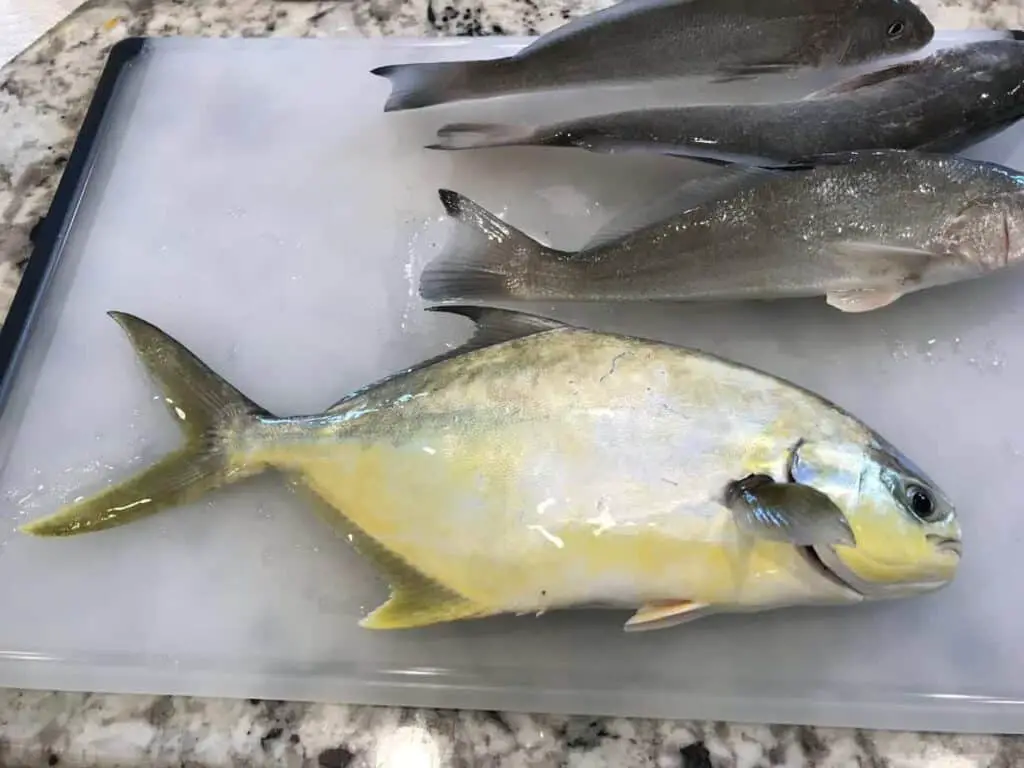
One of the most popular fish targeted from the beach is the Pompano. This fish is known for its excellent table fare, as well as its pound-for-pound fighting ability. Pompano can be caught all along the Gulf and Atlantic coasts from South Texas, around the tip of Florida, and up to Massachusetts.
Pompano can be identified by their greenish-grey back that fades into a silver midsection and yellow belly. They have a small mouth and a gently sloping forehead that leads into a short upright dorsal fin and a wide, upright forked tail. Pompano is relatively small in size, commonly 1 to 2 pounds and 10 to 14 inches in length, but can be as large as 8 pounds and 25 inches.
Pompano draws a striking resemblance to their much larger cousin, the Permit. Anglers will commonly misidentify a small Permit, in the 4 to 8 lb range, as a big pompano. To help prevent this misidentification, The Florida Fish and Wildlife Conservation Commission provides a very good reference to help distinguish these two fish apart. I encourage you to click here to visit the FWCC website to learn more.
Pompano generally likes to cruise up and down the coastal beachfront, right in the 1st and second troughs between nearshore sandbars. Here, the fish are hunting for small crustaceans, specifically the sand flea (aka mole crab), and small crab. A rising tide will bring the pompano in closer to shore where they chase these sand fleas and crabs who are being driven out of the sand by the rising tide. Because of this, the best time to catch Pompano from the beach is during a rising tide, especially an hour before and up to high tide. The Pompano bite will generally slow down during slack and falling tides.
The best bait to use for catching Pompano from the beach is natural and live sand fleas, followed by fresh shrimp, clams, and squid. Fish Bites in either Sand Flea, Shrimp, and/or Clam flavor is a great substitute for fresh natural bait which can be fished the same way as the natural bait. I have actually, on a regular occurrence, outfished my natural baited lines with artificial Fish bites. I always have a pack or two in various flavor and color options in my tackle box just in case natural bait isn't doing the trick.
Click here to order Fishbites from TackleDirect.
The best rig to catch Pompano from the beach is the Pompano rig. This rig is a modified double drop rig that is made up of a monofilament or fluorocarbon leader line with two down drops that usually have colorful beads and floats. There are many options out there for a prebuilt pompano rig, and my favorite is the pompano rig made by Caleb couture.
Pompano can also be targeted from the beach using artificial lures such as small jigs. This can be very fun when using light tackle, which would be required to cast these lures, to really feel the fighting power of the Pompano.
Fly fishermen can also have a great time on the beach if the wind and surf conditions are just right. Most fly fishing anglers will target Pompano using the same small sinking flies that are commonly used for bonefish .
4. Redfish (Red Drum)
Another popular fish that is commonly caught at the beach is the red drum, otherwise known as the redfish. These fish are a popular target because of their long and powerful fight as well as their excellent table fare. Redfish can be found anywhere along the Gulf and Atlantic coasts including South Texas, across the northern Gulf coast and panhandle, all of Florida, and as far north as Massachusetts.
Redfish can be identified by its copper-bronze upper body that fades into a lighter belly and one or more dark spots at the base of the tail. The most common redfish caught will be around 4 to 8 pounds however large adult redfish, sometimes referred to as bull red, have been known to get up to 50 lbs.
Most of the time, redfish are targeted in the shallow water flats, along coastal shorelines, or around shell bars and other structures. However, redfish are also plentiful right off the beaches where they cruise up and down the coast hunting for baitfish, crabs, shrimp, and mollusks such as clams.
I have found that the best time to catch redfish from the beach is in the evening, right at dusk with an incoming tide just before high tide. During this time, crabs and sand fleas are exposed by the rising tide, making them easy targets for the bottom-feeding redfish. Early morning, before the water temperatures rise too much, on the incoming tide can also be a good time to target redfish from the beach as well. Redfish can be caught from the surf during the middle of the day, but chances are much lower because they tend to move to deeper waters during the hottest part of the day.
The best bait for catching redfish from the beach is live shrimp, crab, and baitfish such as finger mullet, croaker, and pinfish. Beach fishing anglers are also successful with fresh cut bait such as clam, squid, mullet, pinfish, and ladyfish. With any of these baits, you will want a rig that keeps the bait secure in your target fishing area, while also keeping the bait off the bottom where it will get picked apart by the small crab. To accomplish this, the best rig to catch redfish from the beach is either a fishfinder rig for live bait and large cut bait or a double drop rig for small cut bait. I will rig any of these with a fish finder rig using a 1/0 to 4/0 circle hook (depending on the size of the bait) and a 3oz to 6oz lead sinker (depending on the surf conditions).
Artificial lures such as topwater lures, jerk baits, jigs, and swimbaits are all great lures that can bring in a nice red. Fishing with artificial is my favorite way to target redfish in the surf, especially if water clarity will allow for sight fishing.
5. Black Drum
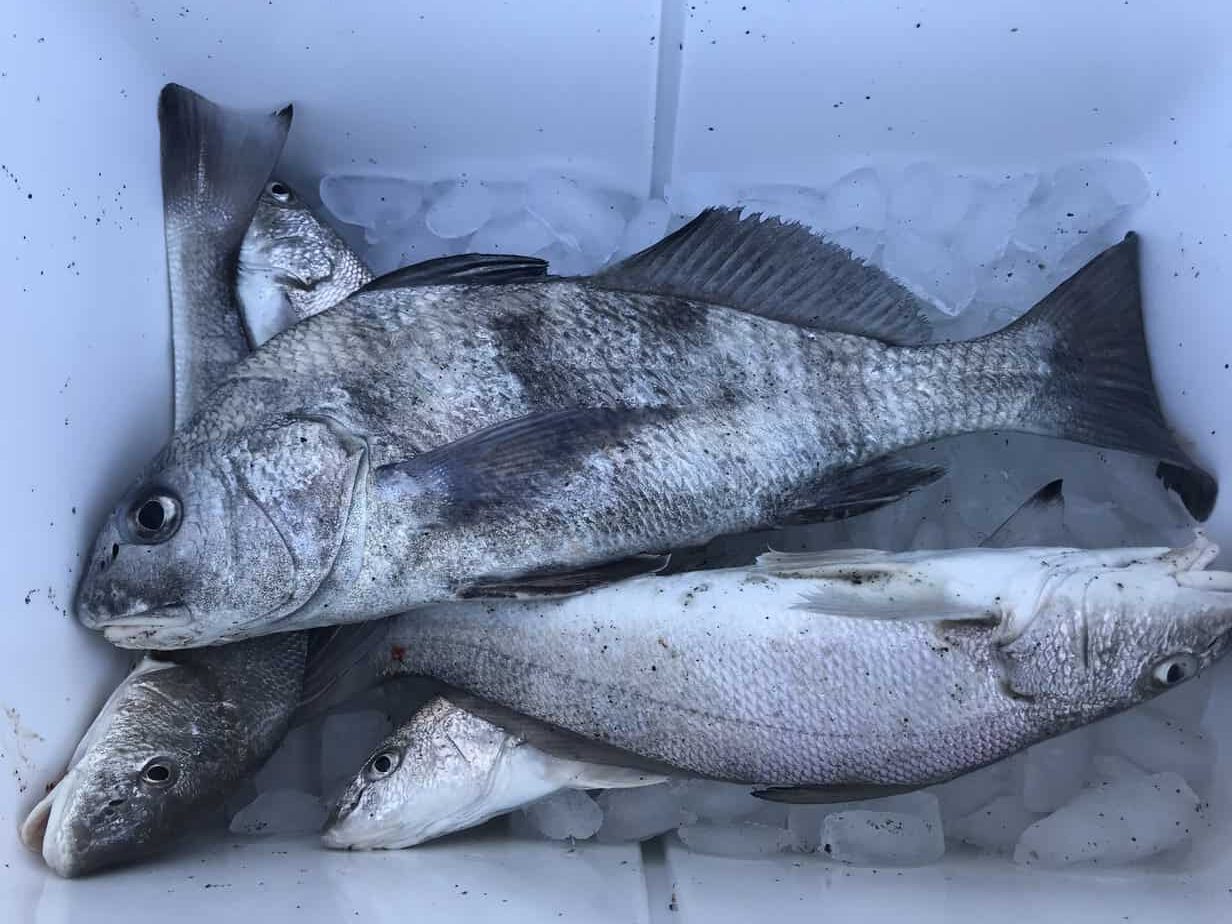
Black drum, otherwise known as big uglys, is another very popular fish caught off the beach when surf fishing. These fish are known for their very large size, unpleasant appearance (hence their nickname), and powerful fight. Smaller drum, in the 5 to 10 pound range, are also very good tasting, similar to their red drum cousin. The black drum can be caught off most beaches in the U.S. and are most prominent along the Gulf Coasts as well as Atlantic coastlines from Florida to Massachusetts.
The black drum has a very deep and stocky body with a pronounced arch in its back and barrels on its lower jaw. They are gray or black on top which fades into a lighter gray on the belly. Commonly, juvenile black drums will have 4 to 6 vertical bars on their sides that some anglers misidentify as sheepshead and spadefish.
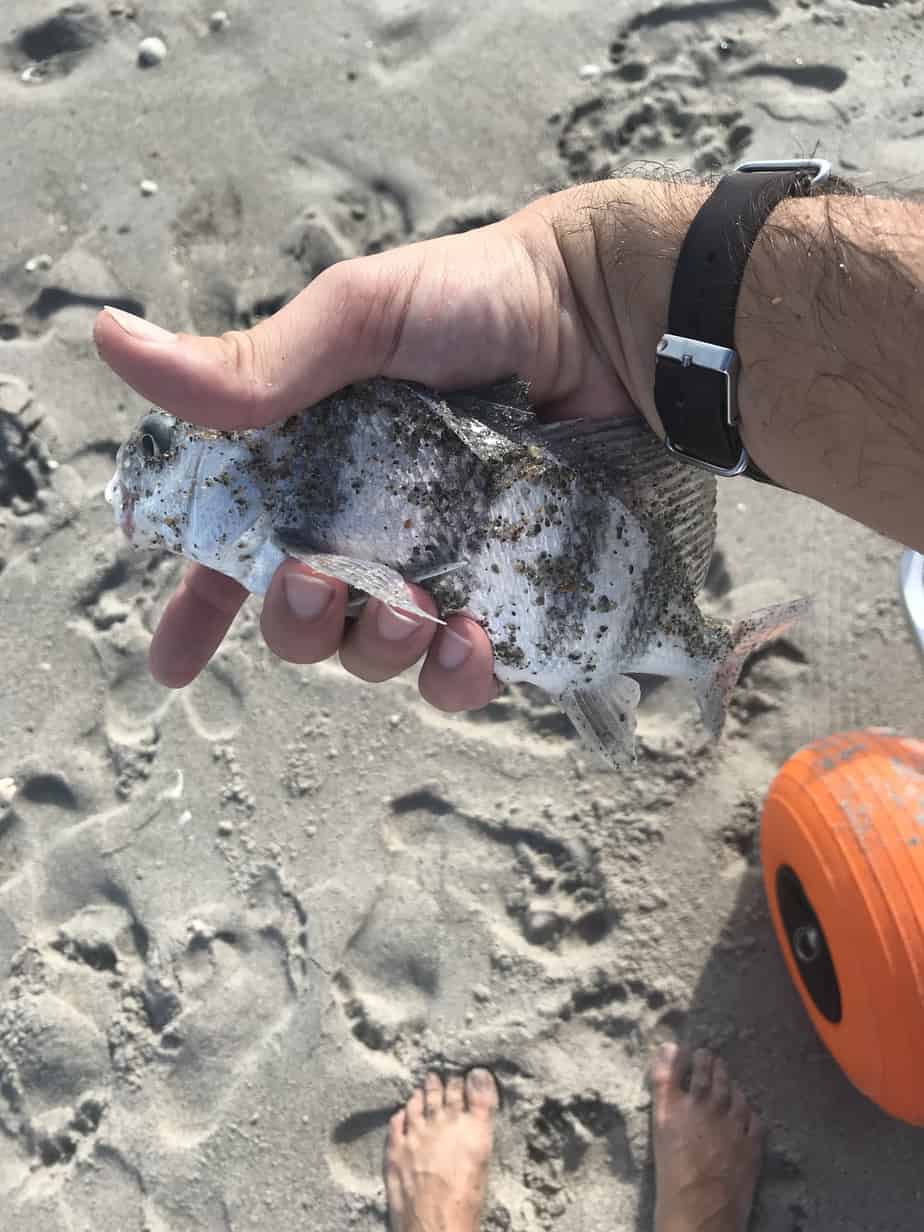
Black drum can get very large in size, up to 100 pounds in some instances. Most commonly, black drum caught off the beach is much smaller than this and are usually between 5 to about 15 pounds. However, some larger black drum can be caught from the shore on occasion. Black drum in this size range is usually best for harvesting as their meat is usually cleanest. Larger black drum are often released as they are fun to catch but are known to have very tough, gamey, and wormy meat.
Black drum come close to shore in search for mullusks and crustations. These baits get washed out of their sand holes as the tide moves in which exposes them briefly to passing fish such as the black drum. As a result, the best time to catch black drum from the beach is during an incoming tide. While drum can be caught all through the day, I have found that the action is best in the evening hours during this incoming tide.
The Black drum is a bottom-dwelling fish whose diet mostly consists of mollusks such as clams, oysters, and scallops as well as crustaceans such as crabs and sand fleas. The best bait to catch black drum from the beach is live fiddler crabs, sand fleas, and shrimp. Fresh or fresh frozen clam, shrimp, and squid are also very good options as well as fresh cut bait such as mullet, pinfish, and ladyfish. If you can't get your hands on any natural bait, fish bites are also a great option in the sand flea, shrimp, and clam flavors.
With any of these natural baits or fish bites, the best rig to use is a high-low or top-bottom rig with a 1/0 to 2/0 circle hook and 25 pounds to 30 pound monofilament or fluorocarbon. I have also had a large amount of success with juvenile black drum on pompano rigs.
6. Bluefish
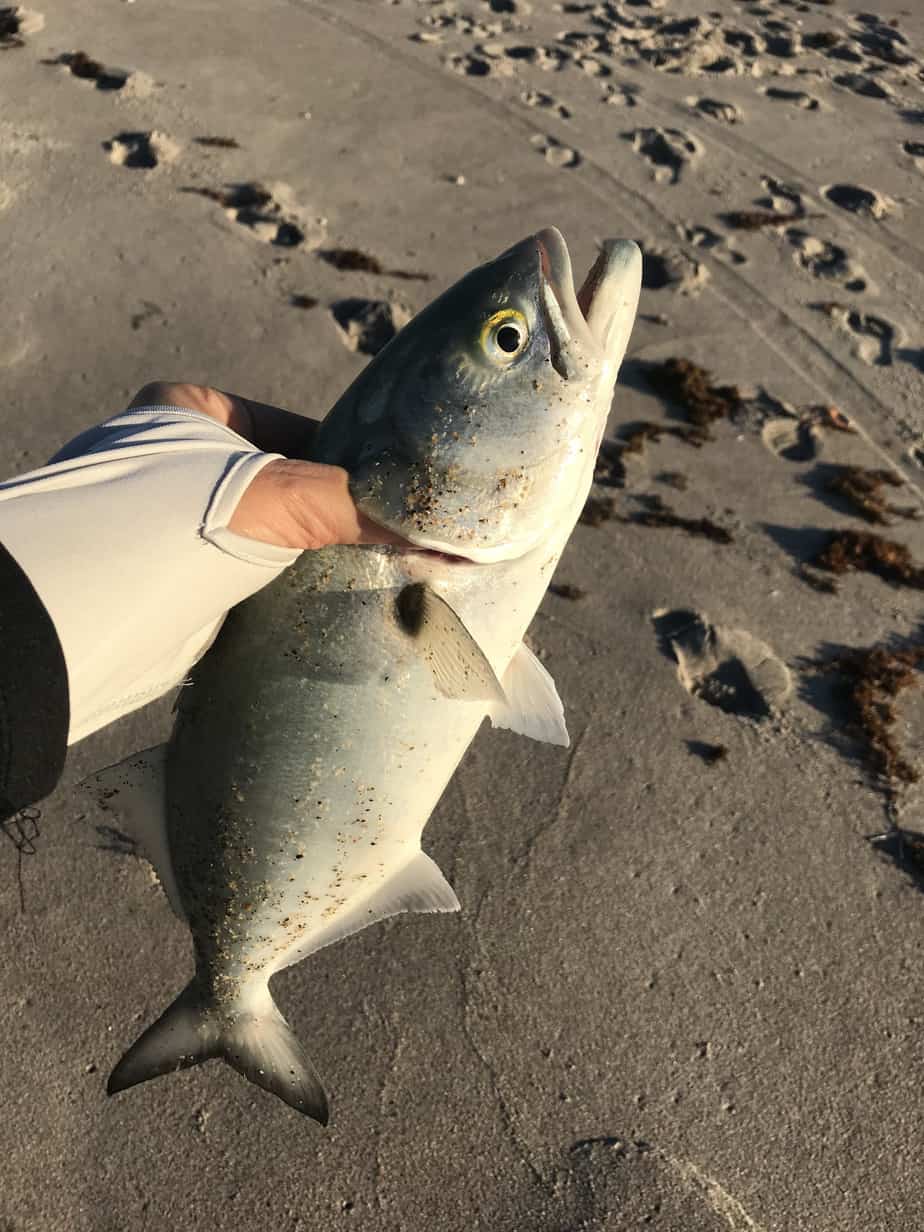
Another fish that is plentiful at the beach is the bluefish. This fish gains its popularity for its ease to catch, especially with artificial lures and light tackle, as well as its aggressive and powerful fight. This fish is harvested by some anglers, but isn't known for the best tasting meat. However, if you bleed it immediately and clean it fast it can be a very good eating fish when fresh. I personally love a smoked bluefish fish dip. Bluefish can be caught from most any Gulf or Atlantic beaches.
Bluefish can be identified by their bluish-green back that fades into silver sides and belly. They have a large mouth with prominent sharp teeth and a pointy nose. They are typically around 3 to 5 pounds when caught off the beach, but can grow up to 30 lbs. The world record bluefish as of Jul 2021 was caught in North Carolina and weighed in at 31 pounds.
Bluefish are schooling fish that generally consist of similar-sized fish. Interestingly, bluefish are cannibalistic, meaning that they will eat small bluefish. These fish are opportunistic feeders that will hit just about anything that moves. The best time to catch bluefish from the beach really is independent of tidal movements as they are simply following the baitfish. Just as many bluefish will be caught on an incoming tide as they will on ad outgoing tide. However, I have found that the best time of day is early in the morning before the beach gets too populated which tends to chase baitfish offshore.
Bluefish are by no means picky when it comes to bait. Realistically, anything that you cast out could get picked up by a bluefish at any point. I have caught them from the beach on everything from finger mullet to sand fleas, crabs, squid, and even artificial fish bites. I have found that The best bait to catch Bluefish from the beach is live baitfish such as small finger mullet, pilchards, pogies, shrimp, and eel. Fresh and natural cut bait such as cut mullet, pinfish, squid, and ladyfish can also work well.
When surf fishing for bluefish with natural bait, the best rigs are ones that can hold the bait in one spot while keeping them off the bottom. I have found that the best rig to use to catch bluefish from the beach is the fishfinder rig with either a stainless steel leader or very thick fluorocarbon leader, 50 to 80 pounds, to protect from their sharp teeth, and 1/0 to 5/0 circle hooks depending on the size of the bait.
I find that the best way, and most fun, is to target bluefish from the beach is with artificial lures and light spinning tackle. I tend to have more success in general with bluefish this way and it is much more entertaining because of the action and the additional sport with lighter tackle. I have found that the best artificial lures to catch bluefish from the beach are gold or silver spoons, topwater plugs, and suspending jerk baits. Just like the natural bait rig, artificial lures will need to be tied to a small strip of the stainless steel leader line to protect against sharp teeth.
7. Snook
Next up in our list of fish that can be caught while beach fishing is the common snook. These fish gain their popularity for their large and powerful stature, aggressive fight, and excellent table fare. Like the redfish, snook is another fish that is commonly targeted by sight fishing in the surf using light tackle and artificial lures, however live natural baits tend to provide more success generally. Unfortunately, unlike most of the fish in this list, the snook is not as abundant and prominent in all U.S. waters. Because of their sensitivity to cold water conditions, the snook will generally only be found in southern central Florida and Southwest Texas.
Snook have a very distinct appearance and are easy to identify by their large mouth with a protruding lower jaw and a black lateral line that extends to their tail. Adult snook that is commonly caught along the beaches range anywhere from 3 pounds up to 15 pounds but can grow over 50 pounds. According to the International Game Fish Association, the world record common snook weighed in at 53 pounds 10 ounces and was caught in Costa Rica.
The best time to catch snook from the beach is in the summer months when the waters are warmest, usually between June and August. During this time, the snook are plentiful in the surf where they are chasing baitfish such as mullet, pinfish, and whiting, as well as crabs and shrimp. The best time of day to catch snook from the beach is on an incoming tide, usually about an hour before high tide up to high tide as well as the first hour of an outgoing tide. Additionally, early mornings and late evenings, when temperatures are at their coolest and the beaches are sparsely populated, will increase the chances of catching snook from the beach.
Snook are regularly targeted from the beach using artificial and natural baits. Along the gulf coasts, many fly fishermen like to walk the beaches early in the morning to cast at the snook cruising in the surf. For snook, the best bait to use is live, natural bait that matches the baitfish prominent in the area you are fishing such as mullet, croaker, pinfish, and ladyfish as well as live crustaceans such as shrimp and crab.
With any of the live bait listed above, I find that the best rig to use to catch snook off from the beach is either free line when surf conditions are right, or a fishfinder rig. With any of these rigs, abrasion-resistant leader line such as fluorocarbon is a must due to their sharp gill plates that can quickly fray and cut most monofilament. Plus, these fish are very observant and can easily be spooked by a visible line.
Depending on the size of bait you are using, the best size hook to catch snook from the beach is anything from a 1/0 to 5/0 circle hook. For small fiddler crab, sand fleas, baitfish, and shrimp, I will usually go with a 1/0 or 2/0 circle hook and for larger baitfish, a 4/0 to 5/0 hook works best to get a good hook into the bait. Because of their aggressive fight, you can run the risk of straightening smaller, weaker hooks. Good quality and strong hook are well worth it when fishing for snook.
During the summer months, when snook is aggressively feeding along the beaches, artificial lures are also great to use. Using artificial really bumps up the difficulty level for catching snook and adds a ton of sport to it, especially using light tackle. Depending on the time of day, water conditions, and baitfish activity, many different artificial lures could work great. In general, I like to use anything from a soft plastic swimbait such as the D.O.A Baitbuster or D.O.A. Shrimp, as well as twitch baits like Mirror Lure. Just like the fish finder rig, or free line rig with live bait, the artificial lures also will require an abrasion-resistant leader line. I like to use about 3 to 5 feet of 20lb fluorocarbon attached to a 25lb braid with an FG knot.
Before you take one of these fish home, be sure to check your local rules and regulation to make sure they are in season and of proper size. Snook are one of the heaviest regulated fish for several reasons including overfishing and natural events such as red tide and unseasonal cold weather. According to FWC, in Atlantic waters anglers are allowed to harvest no more than 1 snook per day that is not less than 28″ or more than 32″ total length between Feb – May and Sep – Nov. Similarly in Gulf waters, anglers are allowed to harvest no more than 1 snook per day that is not less than 28″ or more than 33″ total length between the months of Mar-Apr and Sep – Nov. Furthermore, in the state of Florida, additional fees are required to purchase a snook license in addition to the standard fishing license.
8. Spotted Sea Trout (Speckled Trout)
The spotted sea trout, more commonly referred to as speckled trout, is another great fish to catch when surf fishing. Interestingly, even though it has “trout” in its name, the speckled trout is actually not a trout at all, but instead in the same drum family as the red drum (redfish) and black drum. Anglers like to target Speckled Trout for their aggressive fight and excellent table fare. The speckled trout can be caught from most Gulf side and Atlantic beaches in southwest Texas, across the gulf and around the tip of Florida, and even up to Massachusetts.
The Spotted Sea Trout, also known as speckled trout has a very distinct appearance that makes them very easy to identify. The most obvious attribute of the speckled trout is the numerous black spots that are all along the back and extend to the dorsal fins and tail. The other clear identifier is their large and sharp canine teeth that are located at the tip of the upper jaw. Most speckled trout caught along the beaches will be on the smaller size, around 12 to 14 inches, but these fish can grow upwards of 40 inches and almost 20 pounds.
Speckled Trout are generally most active on the beaches during the summer months when the water temperatures are at the warmest. As the water cools off, in the fall and winter months, they tend to become much less active on the beaches as they tend to venture into deeper, warmer waters.
Speckled trout like to hang out at the beaches along the 1st or second trough, between sandbars, near cuts in the sandbars, or holes. It is important to read the beach when picking a spot for catching speckled trout so you know you are casting in the areas that should be most productive. The best time to catch speckled trout from the beach is on steady moving tides when bait fish are being moving in and out across holes and troughs where specks are waiting for feeding opportunities. I have also noticed that early morning and late evening are also best for speckled trout when beach population is low.
Spotted Sea Trout, or Speckled Trout, have a very similar diet to their red drum cousin. Natural bait, preferably live, will in general catch more fish than artificial, especially for anglers just getting into surf fishing for speckled trout. The best bait to catch spotted sea trout (speckled trout) from the surf includes live bait such as shrimp, fiddler crab, and sand fleas as well as live baitfish such as mullet, pinfish, and hearing.
I have found the best rig to catch speckled trout from the beach using natural bait is the Carolina Rig or the Fish Finder Rig. As for hooks, depending on the size of the bait, a 1/0 to 5/0 circle hook is the best size hook to catch speckled trout from the surf when beach fishing. When using live shrimp, fiddler crabs, sand fleas, and small baitfish I will use a 1/0 circle hook. A larger hook may be required for larger live bait and cut bait, up to a 5/0 circle hook. To learn more about rigging Carolina Rigs and Fish Finder Rigs take a look at our article “Top Natural Bait Rigs To Use When Beach Fishing”. In this article, we go over our favorite rigs and select the right size hooks, and how to bait them.
Speckled trout are also very good fish to target from the beach using artificial lures. When I am fishing from the beach, I always like to toss out a rod or two (up to three) with natural bait while also working the troughs, holes, and cuts along the beaches using a smaller rod and some artificial lures. The best artificial lures to catch speckled trout (spotted sea trout) from the beach include bait-tail jigs, swimming plugs, and topwater plugs.
Speckled trout are a protected species in most states and usually have particular seasons, sizes, and quantity regulations applied to the harvest. For example, in Central East Florida, Spotted Seatrout season is closed from November 1st through December 31st when they are catch and release only. Outside of this timeframe, anglers are allowed 2 trout per person that is more than 15″ and less than 19″ total length.
9. Spanish Mackerel
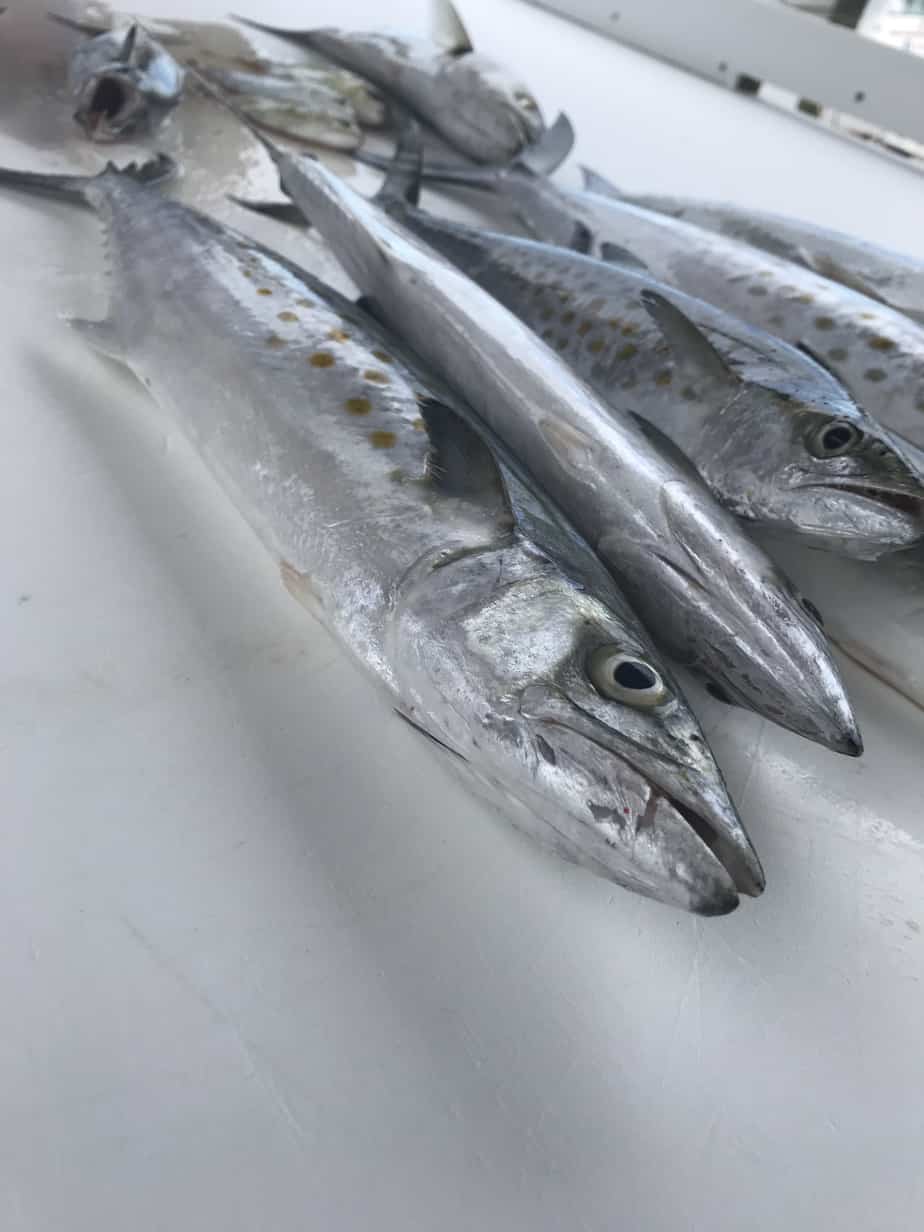
Spanish Mackerel is another commonly targeted fish by many beach fishing anglers. Spanish mackerels are an aggressive and frenzied feeder which makes them very fun to catch when the bite is on because you can catch many of them in a very short amount of time. This is especially a good fish to target for those beachgoing anglers who like to fish using artificial lures as they are very easy to catch with spoons and jigs. Spanish can be found off most gulf coast beaches as well as the Atlantic beaches up to about Virginia.
Spanish is commonly misidentified with the juvenile king mackerel, their larger mackerel cousin. Both the King Mackerel and the Spanish Mackerel are long, sleek fish, with a pointy head and razor-sharp teeth. To correctly identify a Spanish mackerel, you should look for their bluish back that fades into green, a black-blue (not grey) dorsal fin, silver sides and belly with pronounced golden-yellow spots, and a lateral line that goes from gill plate to tail with minimal dip. Spanish mackerel are relatively small members of the mackerel family with the typical size caught from the beach being 14 to 18 inches but they can grow up to 36 inches in size.
They are a schooling migratory fish that will spend most of the winter off the tip of Florida and will start making their way up north as weather conditions warm to a consistent 70 degrees, and will generally hang out until fall when the temperatures start to drop.
Spanish Mackerel are frenzied and aggressive feeders that will hit just about anything that moves and catches their eye. These fish primarily hunt in schools by forcing small baitfish high up in the water towards the surface. This makes finding the schools of baitfish and mackerel apparent by the existence of birds that are drawn to the retreating baitfish now exposed at the surface of the water. These fish generally are not dependent on tidal movements for feeding patterns since they are very opportunistic. However, since baitfish are generally closer to shore on an incoming tide, you will tend to get more opportunities to cast at the Spanish on an incoming tide.
The best bait to catch Spanish mackerel from the beach is live baitfish such as small finger mullet, pilchards, and menhaden. You can sometimes also catch them using fresh chunks of cut bait, live shrimp, or cut squid. I have found that the best rig to catch Spanish mackerel from the beach, with any of the natural bait just listed, is the fishfinder rig with a 25 to 30 lb fluorocarbon leader line, and a 1/0 to 3/0 circle hook, depending on the size of the bait. The fluorocarbon is a must with Spanish to protect against their razor-sharp teeth that will easily damage the monofilament leader line.
While natural bait is good, I actually prefer throwing artificial lures, with light spinning tackle, to target Spanish mackerel from the beach. For an in-depth explanation of light tackle for surf fishing, read my article here. As a matter of fact, I believe more Spanish will be caught with the properly worked artificial than with most natural baits, mostly because artificial bait will give you more casting opportunities and can be presented more precisely. I have found that the best artificial lures to catch Spanish mackerel from the beach are gold or silver spoons, topwater plugs, and suspending jerk baits.
Just like the natural bait rig, artificial lures will need to be tied to a 25 to 30 lb fluorocarbon leader to protect against sharp teeth. With any of these artificial lures, a health leader line is required to protect against their sharp teeth. I normally rig my rod up with 20 to 30 lb braid and 5 feet of 25 to 30 lb fluorocarbon tied on with an FG knot. After about 3 to 5 fish, I will usually need to cut off the last few inches of frayed leader line, and retire my lure.
Spanish tend to be where the baitfish are, which usually means a pretty good distance away from shore. When surf fishing, this is where you may need a rod that will be able to toss your bait and rig out a good way out. When targeting Spanish from the beach I like to look for the jumping and running baitfish and hovering birds to know where my mark is. This is where the advantage goes to artificial because I like to walk the beach to find the baitfish, then work that school until it is unreachable.
10. Shark
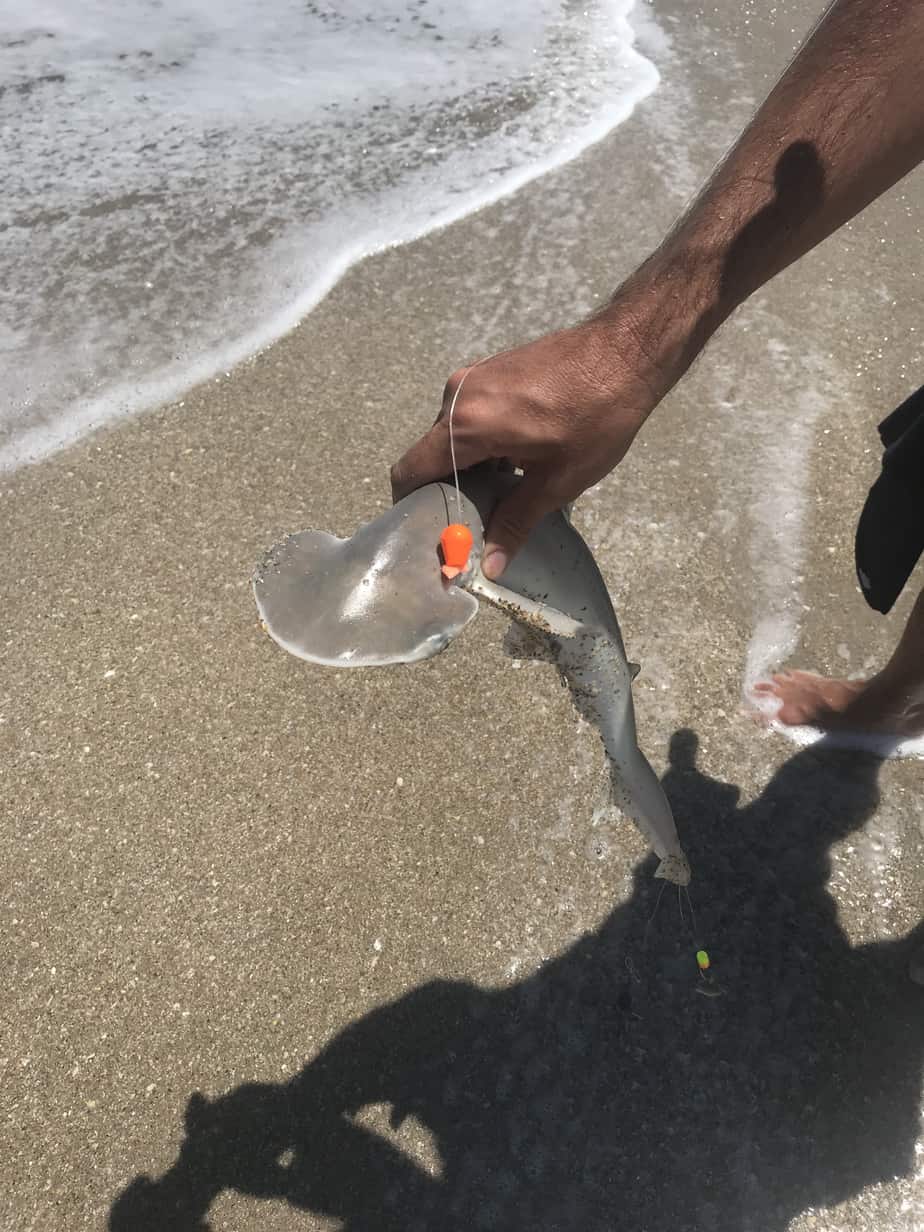
Most commonly, sharks caught off the beach are small species such as bonnethead or shovelhead. However, larger species of shark can also be caught such as blacktip, bull shark, and even hammerhead. Many species of shark can be caught off the beaches. Depending on where you are fishing and the time of year will determine what type of shark might be close to the shore.
Shark fishing from the beach is most popular in the evening hours, from dusk until after midnight. They are most commonly active on a moving tide, when baitfish are also most active.
Live bait or fresh natural bait is best to catch sharks. For the larger sharks, such as bull sharks and hammerheads, some anglers will send out live or fresh dead stingrays a long distance from shore. Pungent, bloody fish such as bonito and ladyfish are also popular baits for catching sharks.
Be sure to check your local fishing regulations before heading out to the beach to go shark fishing. Some states require specific licenses before you can target sharks.
Before you leave, here are a few links that'll take you straight to TackleDirect or Amazon to purchase some of the equipment listed in this article.
- Triple Fish Monofilament Leader
- Seaguar Fluorocarbon Leader
- Pompano Rig
- Sputnik Sinker
- Mustad Circle Hooks
- Fishbites
Be sure to check out our other article, the Best Bait for Surf Fishing to learn more about how to catch these fish. Tight lines and high tides, y'all!
Recent Posts
Fat Cow Jig Strips: The Ultimate Bucktail Jig Upgrade for Surf Fishing
As discussed in my previous article, "Surf Fishing with Bucktail Jigs: Ultimate Guide for Beach Anglers," bucktail jigs are a staple in any surf angler's tackle box, offering a versatile way to catch...
In my previous article, "Surf Fishing with Bucktail Jigs: Ultimate Guide for Beach Anglers," I introduced you to the bucktail jig and discussed how versatile of a lure it is for catching a wide range...

